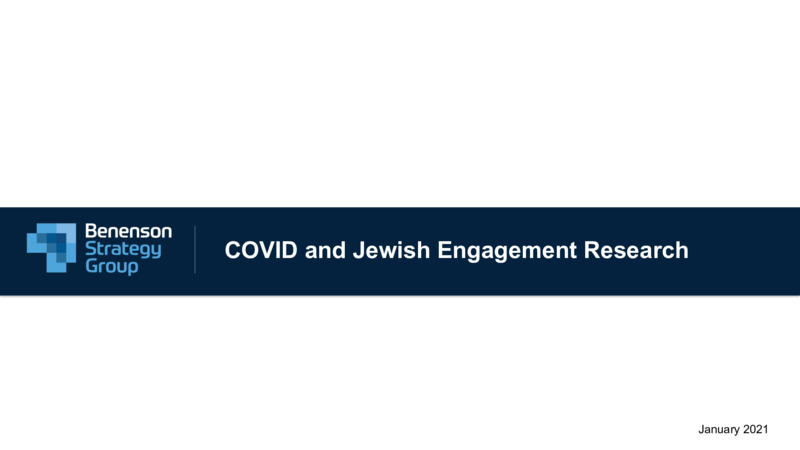Covid and Jewish Engagement Research - High Holidays 2020 Report
This item originates from American Jewish Life.
- Title
- Description
- Date Created
- Community
- Genre
- Language
-
Covid and Jewish Engagement Research - High Holidays 2020 Report
-
Among the many ways that the pandemic profoundly changed Jewish engagement, the High Holidays of 2020 stands out as a particularly fascinating case study. It was a kind of controlled experiment; essentially no one was able to celebrate or observe the holidays in the ways they were used to, so everyone was doing something somewhat different than usual. Institutions of all kinds innovated to adapt to the restrictions, and new ways of engaging emerged and spread more broadly than could have been previously imagined.
In an effort to understand the ways in which people’s engagement with the High Holidays changed during this past year, and what it might reveal about Jewish engagement more broadly, the Charles and Lynn Schusterman Family Philanthropies, Jim Joseph Foundation and Aviv Foundation funded research through the Jewish Community Response and Impact Fund (JCRIF) to illuminate new patterns of participation and motivations. In the winter of 2020-2021, Benenson Strategy Group surveyed 1,414 American Jews nationwide about their experiences of the High Holidays and the ways that those experiences compared to previous years. The research explored not only what people did in 2020, but also compared it to what they had been doing before and explored what they might do in the future. The results provide important insights that have meaningful design implications not only for the upcoming High Holidays, but also for engagement efforts much more broadly.
A major insight is the difference in behavior and attitudes between “Regular High Holy Day Observers” (those who typically observe both Rosh Hashanah and Yom Kippur) and “Infrequent High Holy Day Observers” (those who participate sporadically or only in one of the holidays). Remarkably, approximately half of the Infrequent Observers participated in High Holy Days during the pandemic, when it would have been very easy to opt out (see slide 15). Their robust participation leads us to explore both their motivations for participating and how their participation this year may impact their future decisions and behavior as well.
The motivations of Regular and Infrequent Observers were distinct. While Regular Observers largely report that they were trying to get as close as possible to normal, Infrequent Observers emphasized that they engaged because it was “easy and straightforward” (new modalities, lower barriers to entry [real and perceived, such as social anxiety, complexity of bringing non-Jewish partner, lack of Jewish confidence, managing young kids, etc.]), and because of social motivators, such as recommendations from friends/family, and wanting to “connect with other people like me” (see slide 19). Infrequent Observers responded to a wider and more diverse marketplace of choices during this year, which is an important lesson for future design. In addition to the variety of options, this group now feels more permission to “do Jewish” differently than they may have assumed before.
In addition, Infrequent Observers say that their positive experiences have made them interested in further participation, motivated to share those opportunities with their own friends and family, curious to try new Jewish activities, and try (or consider) new ways to observe the Jewish holidays in the future (see slides 24 and 27). These insights into the behaviors of Infrequent Observers can help create a positive and expanding feedback loop that should pique the interest of those who design such Jewish experiences and seek to engage these populations.
Finally, over 50% of respondents reported that the experience of the pandemic has made them think differently about what being Jewish means, with parents with children under 18 and Infrequent Observers who did participate this year markedly higher than this average.
The controlled experiment of High Holidays during the pandemic was a unique opportunity to conduct this research that illuminated themes which are useful to consider beyond the pandemic.
-
January 2021
-
Charles and Lynn Schusterman Family Philanthropies, Jim Joseph Foundation, Aviv Foundation, Benenson Strategy Group, and the Jewish Community Response and Impact Fund
-
Powerpoint Presentation
-
English

